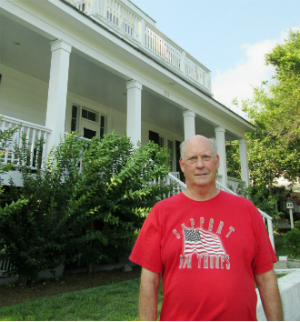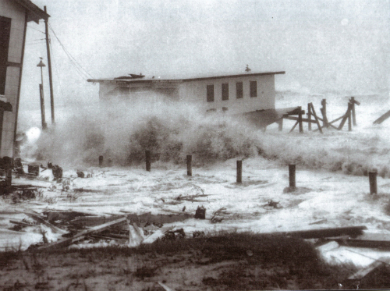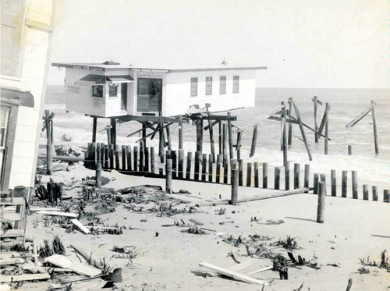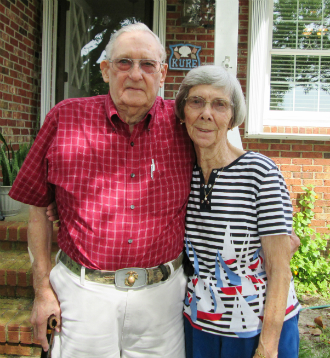Sixty years ago this week, the most powerful hurricane to strike North Carolina devastated much of our coastline. Hurricane Hazel remains one of the benchmark coastal storms against which all others in the state are measured. This is the second of three stories that relive Hazel with people who lived through it and examine the lessons it taught us. This article was first published in the autumn issue of Coastwatch magazine, a publication of North Carolina Sea Grant.
 Charles “Skeeter” Trott stands in front of the Southport home that sheltered his family during Hurricane Hazel. Photo: Pam Smith |
It was Oct. 15, 1954, the day Hurricane Hazel devastated Long Beach in Brunswick County.
“It was the day before my 13th birthday. Not many of the families we knew were lucky enough to live year-round on Long Beach,” says Charles “Skeeter” Trott, whose late father, Charles Moore Trott, was a Long Beach real estate developer.
Supporter Spotlight
With news of the coming storm, the elder Trott sent his wife, Vida Hood Trott, and son to Southport with neighbors Charlotte and Robert Jones, and their young son, Butch. They were to stay with the Arrington family in what today is the Brunswick Inn, a bed and breakfast facing Water Street.
“My dad stayed behind, saying he needed to keep things safe on the island. He woke up before daylight on Friday with the house shaking,” Trott says.
The rising ocean washed away the family car and he was stranded.
Soon the Trotts’ home succumbed to forceful winds, and the two-story house next door blew — or floated — across the road. His dad found refuge in a house the wind had wedged into the woods across the island. There, he waited out the storm clinging to a mattress atop a refrigerator.
“After the storm passed and the tide ebbed, Dad began the 4-mile walk to the swing bridge that would take him to the mainland,” Trott adds.
Supporter Spotlight
Meanwhile in Southport, the storm raged. It was too dark to see anything. “When the eye passed over, Butch and I sneaked out to have a look,” he remembers.
The boys were stunned to see what the first wall of Hazel had done to Southport’s waterfront — fish houses, Harrelson’s grocery store and most waterside structures were gone. Boats were pushed up into yards and houses.
 A view of Southport’s waterfront along Bay Street after Hurricane Hazel hit on Oct. 15, 1954. Photo: Star Newsarchives |
“The second eye wall bashed what was left standing and water pushed up into Bay Street and along the boat basin,” he says. “The storm was scary, but not knowing what happened to my dad was terrifying.
Was he dead or alive? Southport was ravaged. What must have happened on the island? We feared the worst,” Trott recalls.
As soon as they were allowed, they headed to Long Beach. As they got to the bridge they saw a figure walking toward them. It was his father. Tears of relief flowed freely.
Like most residents on Long Beach, the Trott family lost most of their possessions. Remarkably, they discovered a corner china cabinet lying on its side at the tree line. Looters had taken the family silver, but the china was intact.
“Long Beach looked like a desert. The dunes were leveled and Hazel’s surge cut a temporary inlet through the island. Only five houses remained. We felt lucky, even though we lost so much. We came out of it alive,” he says.
Trott graduated from Southport High School in 1960 and soon began a 36-year career as an ammunition inspector at Sunny Point Military Depot. He married in 1962. “And, by the way,” Trott adds, “my wife’s name is Hazel.”
New Hanover Beaches Hit
More developed than Brunswick County beaches at the time, New Hanover County’s Wrightsville Beach and Carolina Beach homes and businesses were ripe for the taking by Hazel’s wind, surge and waves.
On Wrightsville Beach, Hazel wiped out oceanfront cottages, promoting second-row cottages to front-row properties. The iconic Ocean Terrace and Seashore hotels were destroyed and popular fishing piers washed away.
The causeway was littered with fishing boats that broke loose from their moorings and were driven inland by the relentless wind and waves.
Newspapers reported that 14 blocks of Carolina Beach were flooded during the storm, with 362 buildings destroyed and another 288 severely damaged.
Kure Beach Bashed
Jean and Andrew “Punkie” Kure, now 85 and 87 years old respectively, say the ferocity of Hurricane Hazel took many Kure Beach residents off guard.
“It had been wonderful summer and fall seasons. Up to the day before the storm, fish were biting two at a time at the pier,” Jean Kure recalls.
They found themselves in the thick of evacuation plans by mid-afternoon on Thursday. Andrew Kure, volunteer fire chief and emergency manager, received word that the storm was fast-moving, hard- hitting and aiming at the Carolina coast.
He hustled his wife and six-year-old daughter, Linda, across the swing bridge to stay with relatives on the mainland.
The year-round population of Kure Beach at the time was about 100. But there were more than double that number of cottages and apartments in the burgeoning seaside community.
 A powerful wave surge hits the Kure Beach Pier House during Hurricane Hazel. Photo courtesy: Andrew Kure |
 What is left standing of the Kure Beach Pier after Hurricane Hazel. Photo:Island Gazette archives |
“I called the troops together — six volunteer firemen and one police officer — to begin knocking on doors to get people off the island. The wind was howling long before Hazel made landfall,” he explains.
“We continued to knock on doors until we were satisfied that everyone had left or was in the process of leaving. We received little resistance, except for one group of visiting fishermen who were intent on riding out the storm. We warned them that they were in peril, that neither they nor the cottage were likely to survive the storm. They sobered up quickly, packed up and left,” he says.
With warnings complete, Kure fought his way against the wind to retrieve his cat, Tom. They hunkered down with the rest of the crew in the church shelter to wait out the storm, listening to the sound of buildings being ripped apart.
There were some close calls, Kure points out. The bridge tender at the bridge over Snow’s Cut — a manmade canal that connects the Cape Fear River to Myrtle Grove Sound — reported seeing a house break loose and wash through the canal. When the eye passed and winds shifted to the opposite direction, the same house rode the rushing water back through. Somehow, the bridge was unscathed.
 Andrew and Jean Kure have not seen a storm like Hazel before or sine that event. Photo: Pam Smith |
Hazel downed most oceanfront structures. The Kure Pier was destroyed and the pier house left on toothpick-like stilts. Five feet of sand covered U.S. 421 in most places.
The fishermen’s rental cottage? As Kure predicted, it did not survive Hazel’s fury — nor did the Kures’ own oceanfront rental properties.
“I had never seen anything like it before — or since,” Jean Kure says.
Her father, a lineman with the power company, worked day and night for weeks to reset power poles and lines downed by the storm.
“Everyone pulled together. The Red Cross and Salvation Army stayed for a long time with shelter, food and water. And the Health Department came to all affected communities to administer typhoid shots to prevent waterborne diseases,” she points out.
The day after Hazel, Andrew Kure, who had retired from the Marine Corps as a pilot not long before the storm hit, was asked to fly a plane for Jim Jeffries, a photographer with The Greensboro News and Record. They followed Hazel’s course along the southeast coast for an aerial survey of her destruction.
Sixty years later, Kure is still at a loss for words to describe what he saw. “It was hard to take in all that devastation,” he says shaking his head. “It was shocking.”
Carteret County on the Edge
Carteret County, some 120 miles north of Hazel’s landfall, was not spared the storm’s wrath. Surging waters flooded waterfront homes and businesses, including the landmark Sanitary Seafood Market and Restaurant, where John Tunnell, now 83, worked.
He remembers the early warning “of a big one coming our way,” heard through radio messages from ships at sea. Tunnell helped restaurant owner Tony Seamon Jr. prepare for the worst. “We lashed the building to pilings and cut holes in the floor to equalize pressure if the water came in. It came in all right,” he says.
After the storm, he helped the owners clean up. “We set up the Sanitary as a round-the-clock feeding center for work crews from as far away as Tennessee and Alabama doing cleanup in the area,” says Tunnell, who still reports for work at Sanitary.
Margaret Daniels of Williston, who lived with her family on Cedar Island in 1954, remembers Hazel very well.
“The wind was howling while we were eating breakfast. The house was shaking and the walls were swaying. Suddenly the chimney fell through the roof — right into my plate,” she says.
 John Tunnell cut sections in the floor of the Sanitary Fish Market and Restaurant in Morehead City to equalize the water pressure of Hazel’s surge. Photo: Pam Smith |
“In the middle of all this, a neighbor came by to ask if she could pick up the pears that blew off the tree in the high winds. Can you imagine that?” Daniels asks.Natalie Willett Johnson, of Harkers Island, will never forget her wedding day to her late husband, Reis.
They were supposed to be married on Oct. 15 at the home of the groom’s aunt. It had been a whirlwind romance. He was 25. She was 18, spending the summer on Harkers Island before she was to begin her freshman year at what was then East Carolina College.
“We fell madly in love and decided to marry before he entered the Coast Guard that fall,” Johnson relates. It would be a double wedding with Reis’ cousin Coreen and her fiancé Ronnie Chadwick.
On the day of the storm, the wedding party braved the treacherous wind to drive across the bridge to the aunt’s mainland brick home.
Of course, the preacher couldn’t make it. So, the couples married the next day. But when the storm washed out the North River Bridge, plans for a honeymoon in Beaufort or New Bern were dashed. Instead, the newlyweds — both the Johnsons and the Chadwicks — honeymooned at the Sea Level Inn.
After her husband’s Coast Guard career, the Johnsons returned to Harkers Island in 1969, where they resumed life as a commercial fishing family.
Down East fishing communities, including Sea Level and Atlantic, also suffered losses and close calls.
Mildred Willis Gilgo of Atlantic, who was eight years old at the time, recalls what happened to her father, Julian Willis. “My dad left the fishing grounds to get ahead of the storm. The current was cut off on shore early to prevent electrocution, and that meant there would be no lights on shore to guide him as he crossed the shoal. He would be in serious trouble,” she says.
The alert went out through the fishing community, and dozens of people lined up their vehicles along the shore, lights on, to guide him in safely.
“It’s the way we ‘neighbor up’ in a close community,” Gilgo observes. “If you choose a life on the water, you learn to be resilient.”








